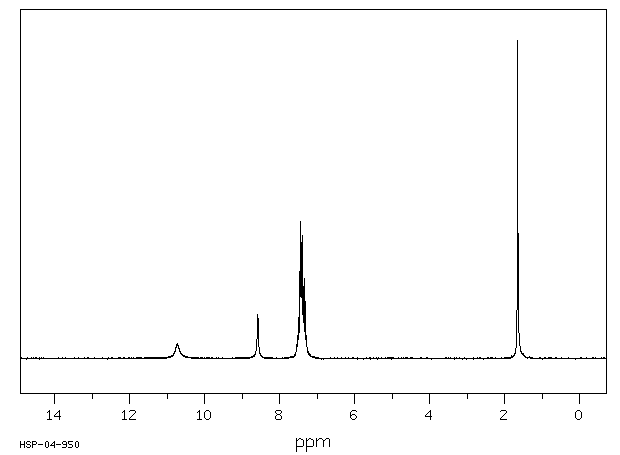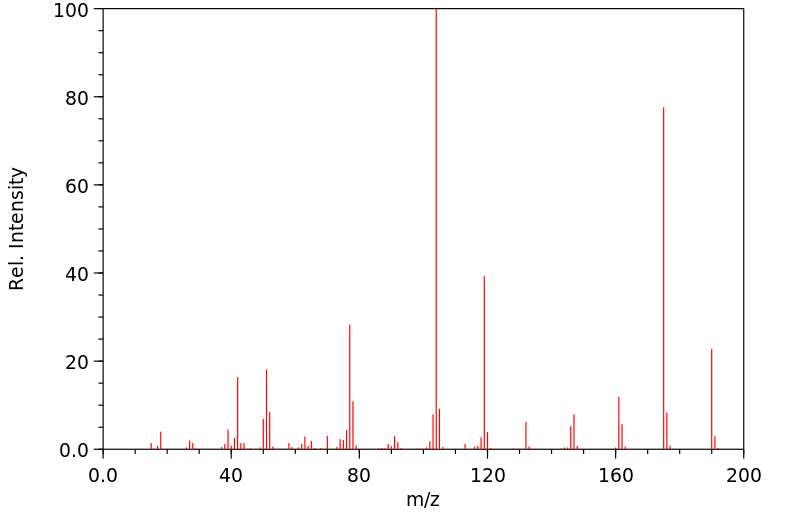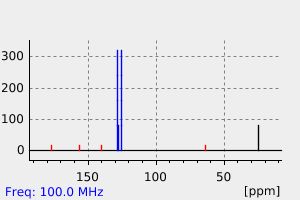5-甲基-5-苯基乙内酰脲 | 6843-49-8
中文名称
5-甲基-5-苯基乙内酰脲
中文别名
5-甲基-5-苯基海因;5-甲基-5-苯海因
英文名称
5-methyl-5-phenylimidazolidin-2,4-dione
英文别名
5-methyl-5-phenylhydantoin;5-methyl-5-phenylimidazolidine-2,4-dione;4-Phenyl-4-methyl-2,5-dioxoimidazolidine
CAS
6843-49-8
化学式
C10H10N2O2
mdl
MFCD00005265
分子量
190.202
InChiKey
JNGWGQUYLVSFND-UHFFFAOYSA-N
BEILSTEIN
——
EINECS
——
-
物化性质
-
计算性质
-
ADMET
-
安全信息
-
SDS
-
制备方法与用途
-
上下游信息
-
文献信息
-
表征谱图
-
同类化合物
-
相关功能分类
-
相关结构分类
物化性质
-
熔点:199-201 °C (lit.)
-
沸点:325.7°C (rough estimate)
-
密度:1.2167 (rough estimate)
-
闪点:9℃
-
溶解度:DMSO(微溶)、乙醇(微溶)、甲醇(微溶)
-
保留指数:1866;1866
计算性质
-
辛醇/水分配系数(LogP):1
-
重原子数:14
-
可旋转键数:1
-
环数:2.0
-
sp3杂化的碳原子比例:0.2
-
拓扑面积:58.2
-
氢给体数:2
-
氢受体数:2
安全信息
-
危险品标志:Xn
-
危险类别码:R22,R36
-
危险品运输编号:UN1230 - class 3 - PG 2 - Methanol, solution
-
WGK Germany:3
-
RTECS号:MU2625500
-
海关编码:2933990090
-
安全说明:S24/25
-
危险性防范说明:P305+P351+P338
-
危险性描述:H302,H319
-
储存条件:室温
SDS
| Name: | 5-Methyl-5-phenylhydantoin 99% Material Safety Data Sheet |
| Synonym: | 2,4-Imidazolidinedione,5-methyl-5-phenyl |
| CAS: | 6843-49-8 |
Synonym:2,4-Imidazolidinedione,5-methyl-5-phenyl
Section 2 - COMPOSITION, INFORMATION ON INGREDIENTS
| CAS# | Chemical Name | content | EINECS# |
| 6843-49-8 | 5-methyl-5-phenylhydantoin | 99.0 | 229-928-6 |
Risk Phrases: None Listed.
Section 3 - HAZARDS IDENTIFICATION
EMERGENCY OVERVIEW
The toxicological properties of this material have not been fully investigated.
Potential Health Effects
Eye:
May cause eye irritation.
Skin:
May cause skin irritation.
Ingestion:
May cause irritation of the digestive tract. The toxicological properties of this substance have not been fully investigated.
Inhalation:
May cause respiratory tract irritation. The toxicological properties of this substance have not been fully investigated.
Chronic:
No information found.
Section 4 - FIRST AID MEASURES
Eyes: Flush eyes with plenty of water for at least 15 minutes, occasionally lifting the upper and lower eyelids. Get medical aid immediately.
Skin:
Get medical aid. Flush skin with plenty of water for at least 15 minutes while removing contaminated clothing and shoes. Wash clothing before reuse.
Ingestion:
If victim is conscious and alert, give 2-4 cupfuls of milk or water.
Never give anything by mouth to an unconscious person. Get medical aid immediately.
Inhalation:
Remove from exposure and move to fresh air immediately. If not breathing, give artificial respiration. If breathing is difficult, give oxygen. Get medical aid.
Notes to Physician:
Antidote: None reported.
Section 5 - FIRE FIGHTING MEASURES
General Information:
As in any fire, wear a self-contained breathing apparatus in pressure-demand, MSHA/NIOSH (approved or equivalent), and full protective gear. During a fire, irritating and highly toxic gases may be generated by thermal decomposition or combustion.
Extinguishing Media:
Use water spray, dry chemical, carbon dioxide, or appropriate foam.
Section 6 - ACCIDENTAL RELEASE MEASURES
General Information: Use proper personal protective equipment as indicated in Section 8.
Spills/Leaks:
Clean up spills immediately, observing precautions in the Protective Equipment section. Sweep up or absorb material, then place into a suitable clean, dry, closed container for disposal. Avoid generating dusty conditions. Provide ventilation.
Section 7 - HANDLING and STORAGE
Handling:
Wash thoroughly after handling. Remove contaminated clothing and wash before reuse. Use with adequate ventilation. Minimize dust generation and accumulation. Avoid contact with eyes, skin, and clothing. Keep container tightly closed. Avoid ingestion and inhalation.
Storage:
Keep container closed when not in use. Store in a tightly closed container. Store in a cool, dry, well-ventilated area away from incompatible substances.
Section 8 - EXPOSURE CONTROLS, PERSONAL PROTECTION
Engineering Controls:
Use adequate ventilation to keep airborne concentrations low.
Exposure Limits CAS# 6843-49-8: Personal Protective Equipment Eyes: Wear appropriate protective eyeglasses or chemical safety goggles as described by OSHA's eye and face protection regulations in 29 CFR 1910.133 or European Standard EN166.
Skin:
Wear appropriate protective gloves to prevent skin exposure.
Clothing:
Wear appropriate protective clothing to prevent skin exposure.
Respirators:
Follow the OSHA respirator regulations found in 29 CFR 1910.134 or European Standard EN 149. Use a NIOSH/MSHA or European Standard EN 149 approved respirator if exposure limits are exceeded or if irritation or other symptoms are experienced.
Section 9 - PHYSICAL AND CHEMICAL PROPERTIES
Physical State: Powder
Color: white
Odor: Not available.
pH: Not available.
Vapor Pressure: Not available.
Viscosity: Not available.
Boiling Point: Not available.
Freezing/Melting Point: 199.00 - 201.00 deg C
Autoignition Temperature: Not available.
Flash Point: Not available.
Explosion Limits, lower: N/A
Explosion Limits, upper: N/A
Decomposition Temperature:
Solubility in water:
Specific Gravity/Density:
Molecular Formula: C10H10N2O2
Molecular Weight: 190.20
Section 10 - STABILITY AND REACTIVITY
Chemical Stability:
Stable under normal temperatures and pressures.
Conditions to Avoid:
Incompatible materials, dust generation, strong oxidants.
Incompatibilities with Other Materials:
Strong oxidizing agents.
Hazardous Decomposition Products:
Nitrogen oxides, carbon monoxide, irritating and toxic fumes and gases, carbon dioxide.
Hazardous Polymerization: Has not been reported
Section 11 - TOXICOLOGICAL INFORMATION
RTECS#:
CAS# 6843-49-8: MU2625500 LD50/LC50:
Not available.
Carcinogenicity:
5-methyl-5-phenylhydantoin - Not listed by ACGIH, IARC, or NTP.
Other:
See actual entry in RTECS for complete information.
Section 12 - ECOLOGICAL INFORMATION
Other No information available.
Section 13 - DISPOSAL CONSIDERATIONS
Dispose of in a manner consistent with federal, state, and local regulations.
Section 14 - TRANSPORT INFORMATION
IATA
Not regulated as a hazardous material.
IMO
Not regulated as a hazardous material.
RID/ADR
Not regulated as a hazardous material.
Section 15 - REGULATORY INFORMATION
European/International Regulations
European Labeling in Accordance with EC Directives
Hazard Symbols: Not available.
Risk Phrases:
Safety Phrases:
S 24/25 Avoid contact with skin and eyes.
S 28A After contact with skin, wash immediately with
plenty of water.
S 37 Wear suitable gloves.
S 45 In case of accident or if you feel unwell, seek
medical advice immediately (show the label where
possible).
WGK (Water Danger/Protection)
CAS# 6843-49-8: No information available.
Canada
None of the chemicals in this product are listed on the DSL/NDSL list.
CAS# 6843-49-8 is not listed on Canada's Ingredient Disclosure List.
US FEDERAL
TSCA
CAS# 6843-49-8 is not listed on the TSCA inventory.
It is for research and development use only.
SECTION 16 - ADDITIONAL INFORMATION
N/A
上下游信息
-
下游产品
中文名称 英文名称 CAS号 化学式 分子量 —— (R)-5-methyl-5-phenylhydantoin 101693-73-6 C10H10N2O2 190.202 —— (S)-5-methyl-5-phenyl-2,4-imidazolidinedione 27539-12-4 C10H10N2O2 190.202 3,5-二甲基-5-苯基咪唑烷-2,4-二酮 3,5-dimethyl-5-phenylimidazolidine-2,4-dione 6844-34-4 C11H12N2O2 204.228 —— 1,5-dimethyl-5-phenylhydantoin 6843-50-1 C11H12N2O2 204.228 —— 4-methyl-4-phenyl-imidazolidin-2-one 5062-77-1 C10H12N2O 176.218 (4-甲基-2,5-二氧代-4-苯基咪唑啉-1-基)乙酸 5-Methyl-5-phenyl-3-hydantoinyl acetic acid 726-88-5 C12H12N2O4 248.238 —— 3-Ethoxycarbonylmethyl-5-methyl-5-phenyl-hydantoin 733-98-2 C14H16N2O4 276.292 —— 5-Methyl-5-phenyl-3-phenylthiohydantoin 81067-98-3 C16H14N2O2S 298.365 —— N-(4-aminosulphonylphenyl)-2-(4-methyl-2,5-dioxo-4-phenylimidazolidin-1-yl)acetamide —— C18H18N4O5S 402.431 —— 3,5-dimethyl-5-phenyl-1-(5-(4-phenylpiperazin-1-yl)pentyl)imidazolidine-2,4-dione 1608154-38-6 C26H34N4O2 434.582 —— N-(3-chloro-4-methoxyphenyl)-2-(4-methyl-2,5-dioxo-4-phenylimidazolidin-1-yl)acetamide —— C19H18ClN3O4 387.823 —— 1-(5-(4-(2-fluorophenyl)piperazin-1-yl)pentyl)-3,5-dimethyl-5-phenylimidazolidine-2,4-dione 1608154-39-7 C26H33FN4O2 452.572 —— 1-(5-(4-(2-methoxyphenyl)piperazin-1-yl)pentyl)-3,5-dimethyl-5-phenylimidazolidine-2,4-dione 1608154-40-0 C27H36N4O3 464.608 —— 3-(4-(4-(1,1,1,3,3,3-hexafluoro-2-hydroxypropan-2-yl)-2-n-propylphenoxy)butyl)-5-methyl-5-phenylimidazolidine-2,4-dione 1031395-11-5 C26H28F6N2O4 546.51 - 1
- 2
反应信息
-
作为反应物:描述:参考文献:名称:Some 5,5-Disubstituted Hydantoins摘要:DOI:10.1021/ja01243a006
-
作为产物:描述:3-(tert-butyl)-1-(4-methoxybenzyl)-5-methyl-5-phenylimidazolidine-2,4-dione 在 甲烷磺酸 作用下, 以 二氯甲烷 为溶剂, 反应 24.0h, 生成 5-甲基-5-苯基乙内酰脲参考文献:名称:Palladium Catalyzed C-Arylation of Amino Acid Derived Hydantoins摘要:Palladium(II) trifluoroacetate (5 mol %) catalyzes the C-arylation of N,N-disubstituted hydantoins by aryl iodides in good yield. The reaction proceeds through base-promoted enolization of the amino acid derived hydantoins, and the resulting 5,5-disubstituted hydantoins may be deprotected at one or both N atoms to yield biologically active structures or alternatively hydrolyzed to the parent a-aryl a-amino acids. The reaction is successful with a variety of parent amino acids and a range of electron-rich and electron-poor aryl iodides.DOI:10.1021/acs.orglett.5b01803
文献信息
-
[EN] PROCESS FOR THE PREPARATION OF IODIDES<br/>[FR] PROCÉDÉ DE PRÉPARATION D'IODURES
-
Process for the preparation of chiral, nonracemic申请人:Hoechst Aktiengesellschaft公开号:US06018053A1公开(公告)日:2000-01-25The present invention relates to a process for the preparation of chiral, nonracemic compounds of the formula I ##STR1## in which R.sup.1 and R.sup.2 have the meanings indicated in claim 1 and which are useful intermediates for the preparation of pharmaceutical active compounds in which, for resolution, a salt is formed from the racemic compound of the formula I and a chiral, nonracemic amino compound. It furthermore relates to compounds of the formula I and esters thereof.
-
LXR AGONISTS AND USES THEREOF申请人:Martinez Eduardo J.公开号:US20170066791A1公开(公告)日:2017-03-09This invention features compounds that modulate the activity of liver X receptors, pharmaceutical compositions including the compounds of the invention, and methods of utilizing those compositions for modulating the activity of liver X receptors in the treatment of cancer.这项发明涉及调节肝X受体活性的化合物,包括该发明的化合物的药物组合物,以及利用这些组合物调节肝X受体活性治疗癌症的方法。
-
[EN] HAT INHIBITORS AND METHODS FOR THEIR USE<br/>[FR] INHIBITEURS DE HAT ET PROCÉDÉS POUR LEUR UTILISATION申请人:ABBVIE INC公开号:WO2016044777A1公开(公告)日:2016-03-24Compounds having a structure of Formula I or a stereoisomer, tautomer or pharmaceutically acceptable salt thereof, wherein R1, R2a, R2b, R3a, R3b, R3c, R4a, R4b, R5, R6, Z and X are as defined herein are provided. Pharmaceutical compositions comprising such compounds and methods for treating various HAT-related conditions or diseases, including cancer, by administration of such compounds are also provided.提供具有公式I结构或其立体异构体、互变异构体或药学上可接受的盐的化合物,其中R1、R2a、R2b、R3a、R3b、R3c、R4a、R4b、R5、R6、Z和X如本文所定义。还提供包含这些化合物的药物组合物以及通过给予这些化合物治疗各种HAT相关病症或疾病,包括癌症的方法。
-
Solution-phase synthesis and evaluation of tetraproline chiral stationary phases作者:Zhi Dai、Guozhong Ye、Charles U. Pittman、Tingyu LiDOI:10.1002/chir.22001日期:2012.4solution‐phase synthesis of multigram amounts of two 9‐fluorenylmethoxycarbonyl (Fmoc)‐protected tetraproline peptides. These tetraproline peptides were then attached to amino derivatized silica gel. The replacement of the Fmoc group with the trimethylacetyl group lead to two tetraproline chiral stationary phases (CSPs). A comparison of the chromatographic behavior of these two solution‐phase‐synthesized
表征谱图
-
氢谱1HNMR
-
质谱MS
-
碳谱13CNMR
-
红外IR
-
拉曼Raman
-
峰位数据
-
峰位匹配
-
表征信息
同类化合物
(R)-4-异丙基-2-恶唑烷硫酮
麻黄恶碱
顺-八氢-2H-苯并咪唑-2-酮
顺-1-(4-氟苯基)-4-[1-(4-氟苯基)-4-羰基-1,3,8-三氮杂螺[4.5]癸-8-基]环己甲腈
非达司他
降冰片烯缩醛3-((1S,2S,4S)-双环[2.2.1]庚-5-烯-2-羰基)恶唑烷-2-酮
阿齐利特
阿那昔酮
阿洛双酮
阿帕鲁胺
阿帕他胺杂质2
铟烷-2-YL-甲基胺盐酸
钾3-{2-[3-氰基-3-(十二烷基磺酰基)-2-丙烯-1-亚基]-1,3-噻唑烷-3-基}-1-丙烷磺酸酯
钠2-{[4,5-二羟基-3-(羟基甲基)-2-氧代-1-咪唑烷基]甲氧基}乙烷磺酸酯
重氮烷基脲
詹氏催化剂
解草恶唑
解草噁唑
表告依春
螺莫司汀
螺立林
螺海因氮丙啶
螺[咪唑烷-4,3'-吲哚啉]-2,2',5-三酮
螺[1-氮杂双环[2.2.2]辛烷-8,5'-咪唑烷]-2',4'-二酮
苯甲酸,4-氟-,2-[5,7-二(三氟甲基)-1,8-二氮杂萘-2-基]-2-甲基酰肼
苯氰二硫酸,1-氰基-1-甲基-4-氧代-4-(2-硫代-3-噻唑烷基)丁酯
苯妥英钠杂质8
苯妥英钠
苯妥英-D10
苯妥英
苯基硫代海因半胱氨酸钠盐
苯基硫代乙内酰脲-谷氨酸
苯基硫代乙内酰脲-蛋氨酸
苯基硫代乙内酰脲-苯丙氨酸
苯基硫代乙内酰脲-色氨酸
苯基硫代乙内酰脲-脯氨酸
苯基硫代乙内酰脲-缬氨酸
苯基硫代乙内酰脲-异亮氨酸
苯基硫代乙内酰脲-天冬氨酸
苯基硫代乙内酰脲-亮氨酸
苯基硫代乙内酰脲-丙氨酸
苯基硫代乙内酰脲-D-苏氨酸
苯基硫代乙内酰脲-(NΕ-苯基硫代氨基甲酰)-赖氨酸
苯基乙内酰脲-甘氨酸
苏氨酸-1-(苯基硫基)-2,4-咪唑烷二酮(1:1)
色氨酸标准品002
膦酸,(2-羰基-1-咪唑烷基)-,二(1-甲基乙基)酯
脱氢-1,3-二甲基尿囊素
脱氢-1,3,8-三甲基尿囊素
聚(d(A-T)铯)










